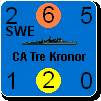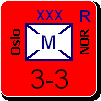wosung
Posts: 692
Joined: 7/18/2005
Status: offline

|
In NW-China WIF locations and setup don't match historical setting in 1939:
1. Communist forces should be strongly concentrated around Yennan, then the only Communist held City on map (8th Route Army).
2. Lanchow should be held by Nationalist forces (perhaps pro nationalist Warlord).
3. Sian should be held by Nationalist 8th Field Army (not by Communists, and not by Warlord Yen Hsi-shan, as I previously stated).
4. In 1939 should be little motivation for Japanese forces to go after Communists.
5. Also there should be little motivation for Japanese player for offensive action in NW for ecconomical reasons. Until now this area is one of the poorest parts of China.
6. In MWIF there should be Partisans on map from the start on (in 1939). remember Sino-Japanese war started in 1937. Quite early on there were Partisan areas in:
-Shansi-Chahar-Hopeh area (mountains west of Peking)
-In Shandong (around Tsinan)
-In Kiangsu, Anhwei, Chekiang, Province, especially in Kiangsi (NE of Nanchang): the New 4th Army
About Yennan:
It was the capital of the biggest, most important CCP Base Area in WW2, the Shaan/Gan/Ning area (Shaansi, Gansu, Ningsia area). Mao Tse-tung and party central commitee resided there in the war (Zhou En-lai was in Chungking as liason-chef). Ammunition manufatories were located in Yennan. Cadre universities were located there. The progressive intelligezia from whole China went there. The 1942 rectification campaigns took place there.
Yennan was overall centre of CCP - because it also was a marginal place, were no enemey had a real motivation to go, when there were other things to do. This was the result of the Long March, not a glorious propaganda tour through China, but a plain flight, escape.
About Lanchow:
After playing around with CWIF I thought, that Lanchow is Communist at set-up.
Problem is: It seems to be wrong, according to most sources, it should be national Chinese.
1. John Keegan (ed.), Times Atlas of Second World War, p. 34-35, 144-145 (depends on edition)
2. I.C.B. Dear, The Oxford Companion to the Second World War, p. 218, map
say so.
3. And in Barbara Tuchman's book about Stillwell, there are hints about him sent for inspection of Soviet Russian war materiel to Lanchow by Roosevelt (Register: Entry "Lanchow" for the pages, because I've a non-English edition).
Lanchow was the chief entry "port" for Soviet Russian war material since 1938. Even SU fighter sqadrons were stationed there (googel it out). Tuchman doesn't state, Lanchow was Nationalist or Communits Chinese. But the point is: SU mainly supported the military speeking seemingly stronger National Chinese to engage Japanese, not the CCP. (Realpolitik instead of ideoloy).
I today even read an George Marshall to Roosevelt quotation online, about Lanchow being the only (farthest) place in North Western China, with Nationalist Chinese Influence (sorry can't find web adress). Apart from that there was a regional warlord around Lanchow, and yes they had a shorttime CCP uprising there in 1936.
Lanchow had for a time some importance as Sovietrussian - National Chinese lend lease "port". There were no big resources around. It was a marginal place.
Additionaly Gansu Province, of which Lanchow was the provincial capital, had quite a strong Chinese muslim population (known as Hui zu). Its was quite independant minded (anti-chinese rebellions in 19th century) and warlike (Nationalist Chinese minister of war, Ho Ying-chin (He Yingqin) was a Hui himself AFIK). And there were muslim militia troops in Gansu.
About Sian:
In WW2 it was Headquarter of 8th Field army under Hu Tsung-nan. He was ex-Whampoa Military student, and therefor a close buddy of Chiang Kaishek. In Sian Hu Tsung-nan worked closley with Tai Li, another Huangpu buddy, then chief of Chinese secret police. There mission (aside from holding Sian) was to put Communist forces under quarantaine. 8th Field Army was a good equipped 400.000 men force. But it was neither best equipped nor only Nationalist force on innerchinese or anticommunist police duty.
Oxford Companion on WW2, p. 230.
Tuchman, Stillwell, see: "Sian" in index.
C'hi Hsi-Sheng, The military dimension 1942-45,in: Hsiung and Levine (ed.) Chinese bitter Victory: the war with Japan, 1937-1945, p. 175
About Warlord Yen Hsi-shan
He was veteran warlord of Shansi province (capital: Taiyuan), not Shensi province (capital Sian). I confused this one. After the loss of Taiyuan 1938 he managed to hold an undecided position between Japan, Nationalists and Communists. In WIF he would be situated between Taiyuan and Sian. But since there's no city between them, he probably won't be part of the game.
Wu T'ian-wei, Contending political forces, in: Hsiung and Levine (ed.) Chinese bitter Victory: the war with Japan, 1937-1945, p. 63.
About Communist partisan areas
Wu T'ian-wei, The Chinese Communist movement, in: Hsiung and Levine (ed.) Chinese bitter Victory: the war with Japan, 1937-1945, p. 79-106.
Johnathan D. Spence China's way into medernity (I hope this is the English title), p- 551-553.
Regards
|
 Printable Version
Printable Version
















 New Messages
New Messages No New Messages
No New Messages Hot Topic w/ New Messages
Hot Topic w/ New Messages Hot Topic w/o New Messages
Hot Topic w/o New Messages Locked w/ New Messages
Locked w/ New Messages Locked w/o New Messages
Locked w/o New Messages Post New Thread
Post New Thread